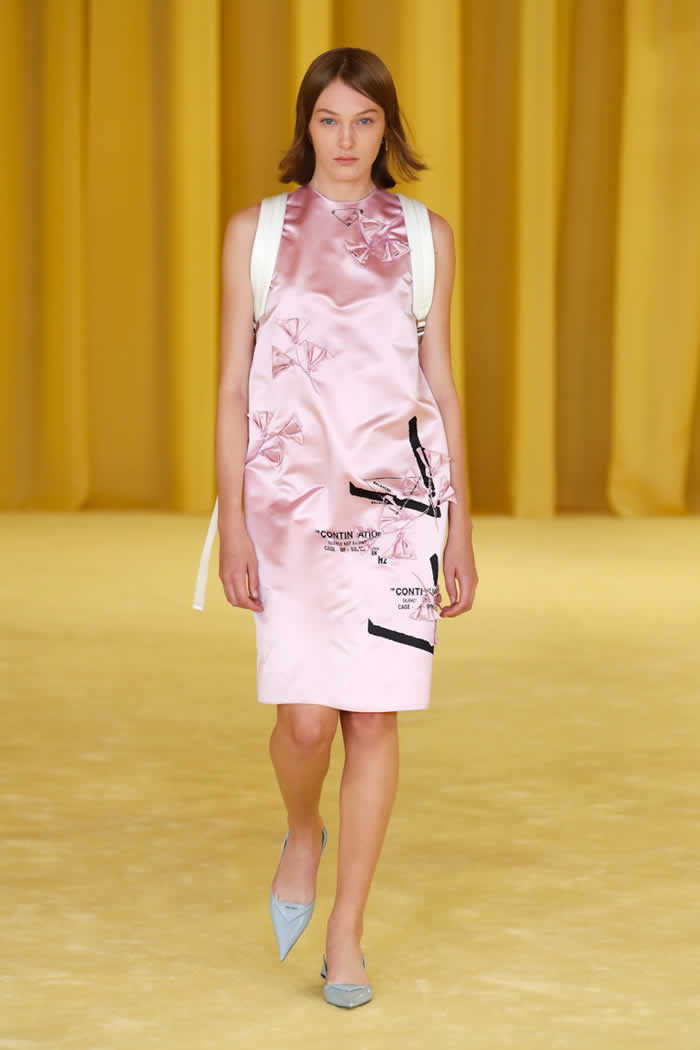History could prove this a seminal moment in fashion: Miuccia Prada, the ultimate feminist designer whose work displays a rare fusion of intellect and emotion, and one of fashion’s most powerful and resolute voices for decades, now coauthoring her brand’s creative output with Raf Simons, himself a major creative voice and revered standard-bearer of heady, modernist fashion.
Her famously distinctive work has a range from austere to voluptuous, while his is more singularly “cool,” (give or take that late-term Jil Sander romance of yore).
For anyone who loves fashion and believes in the purpose and sanctity of the live fashion show, there’s some heartbreak in the fact that this collaboration premiered digitally, as forced by the coronavirus nightmare. On the other hand, one can find kinetic resonance in this particular shift to a digital platform.
“Today, technology is a part of life — the show is a dance between a woman and technology,” “The show is about simplicity — about clothes, and about the dialogue between clothing and the body. That is echoed by a dialogue between technology and the body, technology and humanity.”
The tech-human dialogue was further highlighted by the set, designed by OMA/AMO: a large space, open curtained in ivory in a manner that would have suited an old-time couture house, with cameras and monitors suspended from the ceiling, the latter projecting the name of each girl as she walked.
Further scoring the newness of the situation, each of the young models was making her first runway appearance. “We wanted to represent technology not as a foreign entity, but as an extension of a person, as a friend — as another form of humanity,” Prada said.
Though she referred to the staging, she might have been referencing as well the mood of the clothes. The aura of high-tech futurism showed Simon’s unmistakable, unwavering hand – yet at its point of convergence with “Prada-ness,” a concept addressed in answer to a question in the post-show conversation between the two designers that aired online immediately after the show.
That Prada-ness, he said, “has a very specific attitude, intellect, aesthetic…you can’t really define what it is, but you feel it, it exists, it is there, it’s present.”
Simons elaborated “I was thinking of how I have perceived Prada over 25 years, and one thing that came out instantly was uniform. A uniform gives a sense of community. In a context of reduction, the idea of a uniform is a representation of longevity. In all honesty, I have been looking at Miuccia, how she is dressed, her uniform. It is what she finds important.”
Indeed, “uniform” implies reduction — a focus on fundamental elements. That came through in a tightly organized lineup that homed in on several elements from the Prada milieu, beginning with the Nineties nylon severity through which she established herself as a major influence, and with which Simons’ art-street fusion seems to have the most in common.
The looks here were less rigid than their Prada forebears, softened by injections of color into the mostly black and white lineup, and by some interesting, inventive outerwear.
A lovely if the somewhat quizzical point of convergence: The designers’ shared affinity for the “clutch coat,’” which Prada has shown through the years and Simons worked to exquisite, romantic effect in his glorious last collection for Jil Sander. Here, it appeared variously as coat, cape or wrap, often matched to its underpinnings, while softening their stark simplicity.
That future-street attitude gave way to a Fifties-inspired skirt-and-sweater moment updated with holes in the layered knitwear that also read as Simons cool. So did the splashy graphic artwork by Simons’ longtime collaborator Peter de Potter. As for those memorable “ugly” archival prints: all Prada.
Whenever a new designer starts at a storied house, the first collection sets the tone — what will his or her tenure look like long-term? This is a most unusual arrival, since Simons is working with, rather than replacing, Prada — perhaps all the more reason to start from a template of pared-down, highly recognizable references.
The collection was built on very specific Prada references, from its spare, under-clutch-wraps separates down to its singular shoe — a pointy-toe kitten heel, sometimes in a vibrant color in contrast to the prevailing black, white and gray of the clothes. These co-mingled with equally distinct Simons flourishes.
The message thus delivered: Simons’ role is not to dissemble the remarkable Prada iconography, but to expand and advance it. To that end, the show opened with a parade of prominent logos, a statement from the house founder that, make no mistake, this is still Prada, and from her new collaborator, that he arrives not as wanton iconoclast but bold and fearless creative partner.
Happily, after pushing that point for numerous looks, they moved on. Overt signage on bags, backpacks and some shoes — fine. But does the primary customer for Prada’s ready-to-wear want a big Prada Milano triangle placed can’t-miss-it at her throat? Probably not — a significant consideration.
As Prada noted, her and Simons’ goal is to enhance their customers’ lives. “In a time of incredible complexity, what matters? What is meaningful? That is the question we asked ourselves,” she mused. “We wanted to create something that makes sense to people, something that is useful. Everything we do should allow people to live better.”

